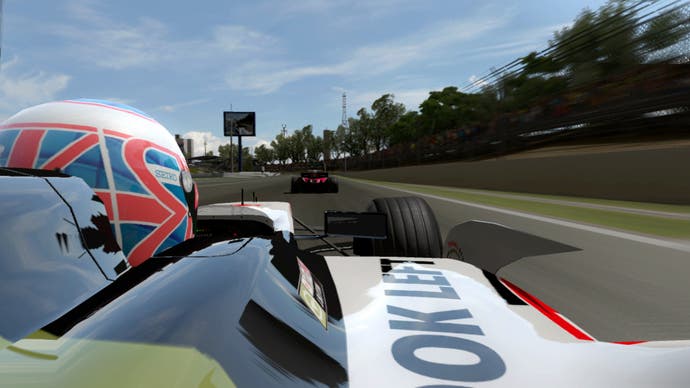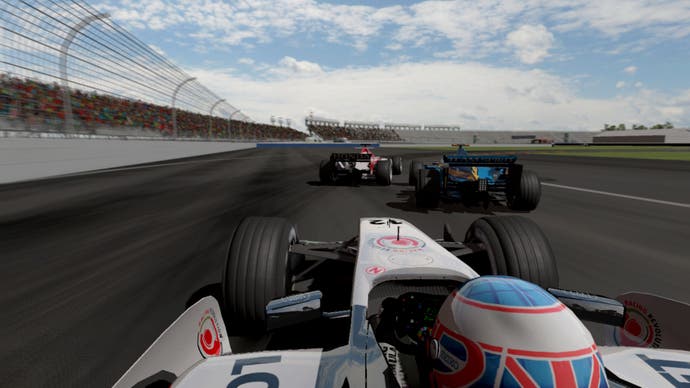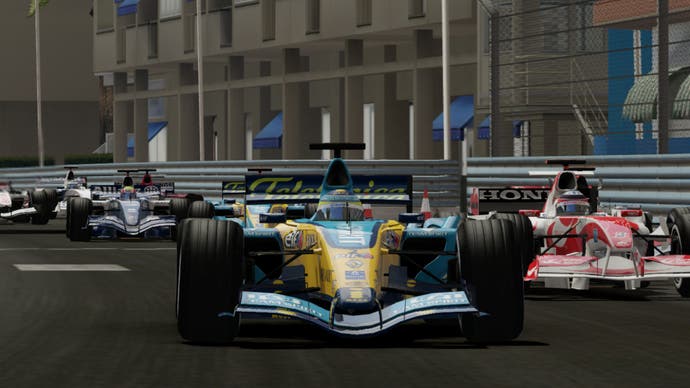Formula One Championship Edition
Gruelling.
Once upon a time, Sony's Phil Harrison demonstrated that games offer better value for money than movies by dividing the length it took to play various games by the amount of money it cost to buy them. So he must be hugely pleased with Formula One Championship Edition because the latest title from the Sony Liverpool production line of officially licensed F1 games goes on forever. Fire up the game's career mode and it'll likely be a good half hour of practising, warming up and setting up the car before you get to the starting grid of your first Grand Prix.
Playing through an entire season of races will probably take a minimum of about nine or ten hours and completing the five-year career mode will therefore take about 45 to 50 hours. And that's just taking part in the bare minimum qualifying laps and races. For players who want to enter into the spirit of the thing and really get involved in the arcane intricacies of the car setup system, they could easily double that amount of time. That's a lot of value for money, and it is, of course, a testament to the rigour and authenticity with which Studio Liverpool has recreated the whole Formula One thing (which is, of course, to be expected from any self-respecting Formula One game these days).

Here's what happens during every race weekend. First there's the Race Car Evolution, which is a series of optional test laps used as the basis for your car's race day setup. The system allows you to configure six different areas of your car and then test them on the track. If you find the idea of racing round an empty track about ten times a bit boring, or if you find it impossible to tell what difference any of the settings make, you can safely skip this section and head straight to the practice laps. If you find the idea of racing round an empty track several times a bit boring, you can also skip that bit. Then it's the qualifying sessions. If you find the idea of racing round an empty track for up to fifteen minutes three times boring, then tough, because that's what you have to do in order to get a good position on the starting grid. That's Formula One.
And then, finally, it's the race itself, where you finally get to compete with other drivers, although like the real thing it's difficult to overtake, and the most minor of prangs will require you to take a premature pit stop, or worse, leave you without a wheel or something equally race-endingly bad. And on the default lap settings, a premature pit stop means any hopes of a podium finish are out of the window, since you have to spend about ten seconds playing a rhythm action mini-game to fix your car or change your tyres. Indeed, since the pit stop is, like the real thing, the most important part of any race, it's a bit of a problem that it's sometimes difficult to make out which buttons you're supposed to press - and it's a shame there's no option to practice your pit stops. Anyway, if you have to stop playing the game in the middle of any of that, you'll have to do it all over again because it doesn't seem possible to save the game in the middle of a race weekend - which means even more value for money, of course.

Here's some of the value that happened during several of my race weekends (having got over the early grievance not being able to create an Irish driver). At Imola, having failed to qualify for the third practice session, a shunt from behind on the first lap led to early retirement (after 18 minutes and 35 seconds). At the Nurburgring, wrestling with the steering assistance for a minute and a half in a bid to get into the pit lane wiped out the advantage of pole position. Completed the race in last place, after 26 minutes and 15 seconds (although the team bosses were still impressed enough to send an email: "Brilliant work Dave," it said. Further evidence that they might not be devoting enough attention to their new driver's burgeoning career arrived later, in the shape of two identical emails sent several weeks apart commending an 'excellent drive'). In Spain, after 27 minutes and 30 seconds of practising, qualifying (in pole) and racing (for 11 minutes), a shunt on the last bend of the penultimate lap led to another early retirement. In the next race, eighteen minutes of Monaco's winding roads in first position proved easy enough till Michael Schumacher caused a crash in the pit lane: another early retirement.

And that's the problem with simulation. One of the facts that flash up during the game's loading screens reveals that Rubens Barrichello has won just nine Grand Prix in his career. And he's a professional racing driver. Formula One races are difficult. So it's a bit of shame that the game's concessions to learner drivers are simply a bunch of driving aids that do the job for you, and some fairly useless instructions tucked away in the menus somewhere. An (optional) interactive tutorial would have served as a much better introduction to the nuances of the sport than basically providing an autopilot. Indeed, as a measure of how much of a copout the driving aids are, leaving the steering assistance, braking assistance, stability control, visual aids, spin recovery, anti-lock brakes, automatic gears, brake bias, and traction control in their default positions enabled your humble correspondent managed to take pole position in the very first race. Switching them off, I struggled to make it round the track. They're driving aids, not teaching aids.

The benefits of simulation are that Sony get to show off all the spangly power of the PlayStation 3. All 18 tracks, 11 teams and 22 drivers from the 2006 Formula One season are present in the sort of meticulous, high definition detail that you won't notice as they blur past while you stare, goggle-eyed at the racing line. And the 11-player online multiplayer mode demonstrates the PS3's network connectivity. Still, it's a shame that the massive capacity of Blu-ray hasn't been used to fit more commentary on: it's a pity, at the start of Sony's next-generation of gaming, to find the commentary or pit crew chatter repeating itself every race. And since they don't offer the sort of precision the game's scrupulously faithful simulation requires, the Sixaxis tilt-steering is basically a novelty, and most drivers will fall back on either analogue stick (or a peripheral wheel).
And that's Formula One Championship Edition. It doesn't contain any real surprises and it does exactly what you'd expect a Formula One game to do. It's a faithful simulation of the sport: just like the real thing, it's mildly diverting, good for soaking up a hangover at the weekend but goes on far too long. And some people will be love it so much that they'll sit up all night just to catch a few qualifying sessions from Malaysia, or Australia, or wherever. Just like every Formula One game.
